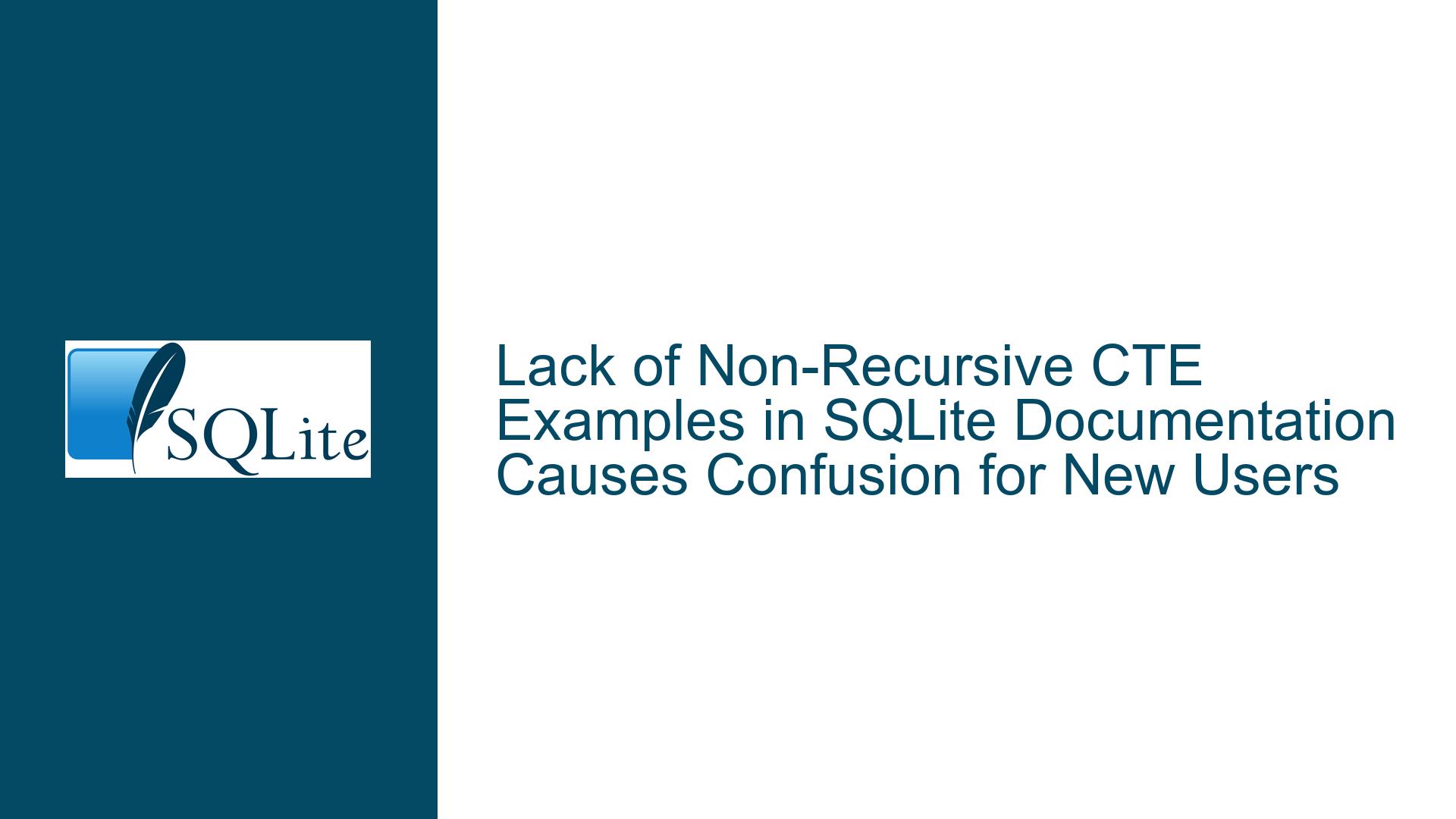Lack of Non-Recursive CTE Examples in SQLite Documentation Causes Confusion for New Users
Understanding the Gap in Non-Recursive Common Table Expression (CTE) Documentation
The absence of explicit examples for non-recursive Common Table Expressions (CTEs) in SQLite’s official documentation creates a significant barrier for developers transitioning from basic SQL syntax to advanced query structuring. While the documentation extensively covers recursive CTEs—used for hierarchical or iterative data traversal—it neglects foundational use cases for ordinary CTEs. Non-recursive CTEs serve as temporary result sets that simplify complex queries, improve readability, and modularize logic within a single SQL statement. New users often misinterpret the WITH RECURSIVE clause as the only valid form of CTE declaration, leading to confusion when attempting to implement non-recursive use cases. This documentation gap forces developers to infer syntax patterns from recursive examples, which may introduce errors or discourage adoption of CTEs altogether.
Non-recursive CTEs are distinct from their recursive counterparts in both syntax and application. A standard CTE does not reference itself in subsequent subqueries and is typically employed for:
- Breaking down multi-step data transformations
- Reusing subquery logic across multiple parts of a main query
- Enhancing readability by isolating complex joins or filters
The lack of explicit examples causes new users to conflate the WITH and WITH RECURSIVE keywords, leading to unnecessary code complexity or failed query execution. For instance, a developer attempting to create a temporary result set for filtering aggregated data might mistakenly include the RECURSIVE keyword, triggering parser errors if no recursive structure is present. This issue is exacerbated in SQLite, where the WITH clause syntax mandates strict adherence to the recursive/non-recursive distinction.
Root Causes of Documentation Gaps and Misinterpretation Risks
The omission of non-recursive CTE examples stems from three primary factors:
Assumption of Prior SQL Knowledge: SQLite’s documentation often assumes familiarity with CTE syntax from other SQL dialects like PostgreSQL or MySQL, where non-recursive CTEs are more prominently demonstrated. This creates a blind spot for developers who rely solely on SQLite-specific resources.
Overemphasis on Recursive Use Cases: Recursive CTEs solve niche problems like tree traversal or graph analysis, which are inherently more complex. Documentation authors may prioritize these examples to highlight SQLite’s advanced capabilities, inadvertently overshadowing basic CTE applications.
Ambiguity in Keyword Syntax: The
WITH RECURSIVEclause in SQLite is syntactically valid even when no recursion occurs. For example, a CTE declared withWITH RECURSIVEbut lacking a self-referential subquery will execute without errors, misleading developers into believing theRECURSIVEkeyword is mandatory.
These factors converge to create a learning curve where developers must reverse-engineer non-recursive CTE syntax from recursive examples. This process introduces risks such as:
- Unintended Recursion: Adding a self-referential subquery by accident when copying recursive CTE structures.
- Parser Errors: Omitting the
RECURSIVEkeyword in a non-recursive CTE (which is actually correct) but assuming it’s required due to documentation examples. - Performance Misconceptions: Believing that all CTEs incur the overhead of recursion, leading to avoidance of non-recursive CTEs in favor of less readable subqueries.
Resolving Non-Recursive CTE Implementation Challenges Through Examples and Best Practices
To address the documentation gap, developers can apply the following structured approach to implement non-recursive CTEs in SQLite:
1. Basic Non-Recursive CTE Syntax
A non-recursive CTE is declared using the WITH keyword followed by a CTE name, an optional column list, and a subquery. The RECURSIVE keyword is omitted.
WITH regional_sales AS (
SELECT region, SUM(amount) AS total_sales
FROM orders
GROUP BY region
)
SELECT region, total_sales
FROM regional_sales
WHERE total_sales > 1000;
This CTE calculates total sales per region and filters results in the main query. Unlike recursive CTEs, there is no self-reference or iterative logic.
2. Multi-CTE Declarations
Multiple CTEs can be chained within a single WITH clause, separated by commas:
WITH
active_users AS (
SELECT user_id, last_login
FROM users
WHERE last_login >= '2023-01-01'
),
user_orders AS (
SELECT user_id, COUNT(*) AS order_count
FROM orders
GROUP BY user_id
)
SELECT au.user_id, uo.order_count
FROM active_users au
JOIN user_orders uo ON au.user_id = uo.user_id;
3. CTEs for Data Transformation
Use CTEs to stage intermediate transformations:
WITH normalized_prices AS (
SELECT
product_id,
CASE
WHEN currency = 'EUR' THEN price * 1.07
ELSE price
END AS usd_price
FROM products
)
SELECT product_id, AVG(usd_price) AS avg_usd_price
FROM normalized_prices
GROUP BY product_id;
4. CTEs with Window Functions
Combine CTEs with window functions for partitioned calculations:
WITH employee_rank AS (
SELECT
name,
department,
salary,
RANK() OVER (PARTITION BY department ORDER BY salary DESC) AS dept_rank
FROM employees
)
SELECT name, department, salary
FROM employee_rank
WHERE dept_rank = 1;
5. Debugging CTE Misconceptions
- Error:
near "WITH": syntax error
Solution: Ensure theWITHclause is placed at the start of the query. - Error:
no such table: cte_name
Solution: Verify the CTE is declared before the main query and correctly referenced.
6. Performance Considerations
Non-recursive CTEs in SQLite act as optimization fences, meaning the query planner cannot fold them into the main query. Use CTEs judiciously for complex logic but prefer subqueries or temporary tables for large datasets.
By systematically applying these examples, developers can bypass documentation limitations and harness non-recursive CTEs effectively. For further learning, consult SQLite’s WITH clause documentation while cross-referencing examples from PostgreSQL or MySQL, ensuring alignment with SQLite’s syntax rules.






